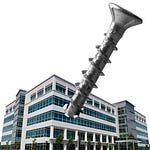Here’s a story about leveraging visibility to maximize transparency by utilizing the transparency paradox. Some years ago, I was elected the chair of the Faculty Council at my university—a representative group of professors who help steer the policies and curriculum of the school. Such bodies are rarely a hotbed of controversy although they can wield considerable influence.
This was my second term as chair, but the Faculty Council was still fairly new—only about six years old—and it was weak by design to keep those pesky faculty members in check. To make matters worse, the Council operated very much in the shadows, holding allegedly public meetings in a cramped conference room at night when everyone else was home eating dinner. If we had any visitors, the awkwardness and discomfort they faced would assure they never pulled that stunt again.
I was one of the founding members of the Faculty Council, and my first term as chair had come only three years after the Council’s founding and mostly involved creating elementary systems and protocols and revising the sloppily-crafted Council by-laws. I devoted my second term to structural reform and casting off some of the excesses and shortcomings that had already accrued over the brief time the Council had been in existence.
As young as the Council was as an organization, its opacity and irrelevance were already beginning to set like hardening cement. The faculty that paid any attention to us did not trust us, and nobody else cared at all. In my assessment, we only had one last best chance to turn the Council—weak as it was—into the legislative body it had promised to be at the outset before we would drift into permanent irrelevance.
I summarized my initiative in a catchy little slogan: “Transparent but not invisible.” Sexy, huh? Well, maybe not sexy, but rather cheeky for the uptight world of academia—where fun goes to die.
Let me break it down a bit. In the literal sense, transparency and invisibility are almost the same thing. If something is transparent, it is see-through while an invisible object is not seeable at all. Still, you can have transparent objects that are not invisible, but invisible objects are always technically transparent. A window is transparent, but under most circumstances it is not invisible. You can see the glass. At night, though, it can become invisible with the right conditions. Air, on the other hand, is both perfectly invisible and transparent, except when those Canadian wildfires get going.
With leadership it is a somewhat different story. To be most effective, leaders must be both transparent and visible at all times, at least in the metaphorical sense. Transparency here has to do with openness and candor. Visibility has to do with being as conspicuous as possible to your constituents. What makes it interesting is that, unlike in the physical world, the more visible you are as a leader, the more transparent you become.
And that, my friends, is the transparency paradox in a nutshell. To become more transparent as a leader, you must consciously become less invisible. That was my goal with Faculty Council—to fling open the doors so that everyone could see what we were doing in real time. It was a dual message:
Nothing to hide here.
And we do a lot of important stuff.
To become more visible, we had to be more public, so I moved us from our narrow conference room to a more prominent and wide-open space that could comfortably accommodate an audience. Instead of nighttime meetings under cloak of darkness, we convened in the midafternoon at a time when few classes were in session. No more operating in the shadows. To make the whole operation more welcoming, I arranged long tables in the shape of a wide V. The Council would sit behind the tables so that they were able to see each other. Audience members sat in chairs lined up in the mouth of the V from which vantage they could witness our deliberations and even participate when appropriate.
I was already pretty expert in Robert’s Rules of Order and used them to maximize our openness and fairness. Parliamentary protocols can seem stuffy and overly formal when they are misunderstood, but used correctly they supply logical structure, enhance equity, and move things along. As the meetings progressed, I would demystify the rules of order by explaining how they functioned. As tedious as all this sounds, the effect was just the opposite, and I was regularly complimented for the lively flow of my meetings.
My masterstroke, though, really spoke to the hearts, or maybe tummies of the faculty: Snacks! Yup. At first I paid for them out of pocket, but I eventually begged a small budget from the administration to lay out some food and beverages at Council meetings. As soon as word got out that there was free food, we saw attendance tick up.
All this was quite new to our university culture. Faculty there pretty much had always just put their heads down and their shoulders to the wheel, so I can’t say we suddenly had mobs of faculty and staff attending SRO meetings. Far from it. More realistically, my goal was to quickly shift the culture of the Council and—more slowly behind it—the culture of the university. Here’s my reasoning: Heightened visibility invited scrutiny; scrutiny invited accountability. And, since we had nothing to hide, accountability invited transparency. Plus, let’s not forget: snacks invited visitors!
To be clear, while my eye was focused on the present, I knew I was laying the groundwork for future Faculty Councils. Therefore, at the end of my term, I capitalized on our modest success to get even more accommodations from the administration even though I was stepping down from the Council. I convinced them to increase the food budget and commit to designating one hour each month solely to the Faculty Council meeting. Nothing else would be scheduled then. In subsequent years, the monthly Faculty Council meeting became a destination lunch, attended by the faculty and an array of top administrators, including the president. We even had the occasional student there. In less than two years, we had transformed the Council from a private club teetering on the edge of utter irrelevance into a full-fledged governing body that people wanted to know more about.
Think about it. We accomplished this turnaround by leveraging visibility to maximize transparency: the transparency paradox! Actively seeking visibility—operating in the open in full daylight in plain view—makes it impossible to be anything but transparent. It seems counterintuitive, finding transparency in visibility, but there it is.
Leaders who are intentionally transparent invite scrutiny and the accountability it demands. Their visibility assures their openness and candor and engenders healthy trust. And if you can’t fully trust a leader, what use are they? They might as well be invisible.
How do you assure you are both visible and transparent as a leader? What are the advantages of leadership transparency?
Great leaders must learn to leverage visibility to maximize transparency, and I can help.
Unlock the Great Leader Within! Download my free resource, the Transform To GREATness Toolkit, now!
I look forward to hearing from you.
Intro and outro podcast theme music by LiteSaturation from Pixabay.
If you want to invite me speak at your event or appear on your podcast, visit these pages for more information:













